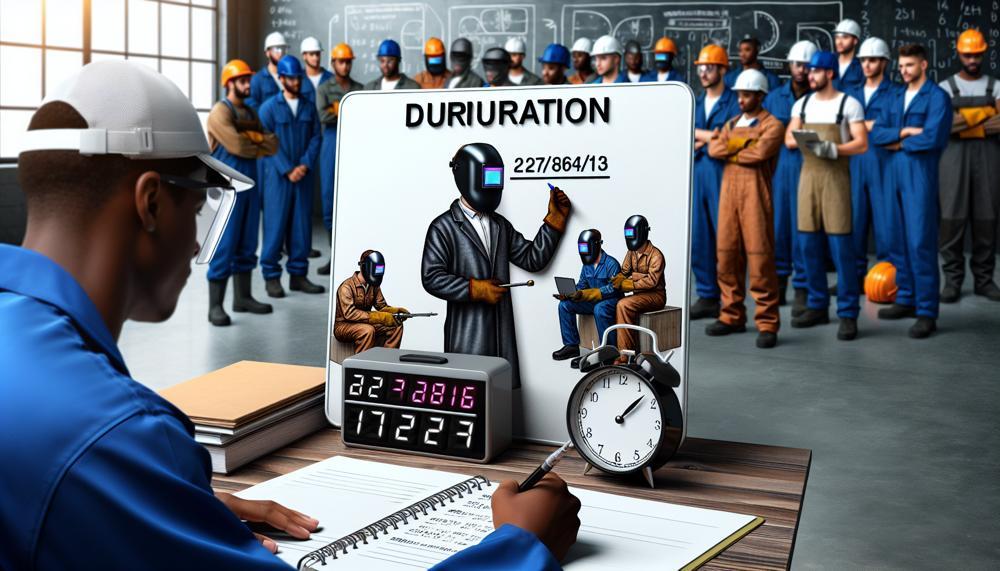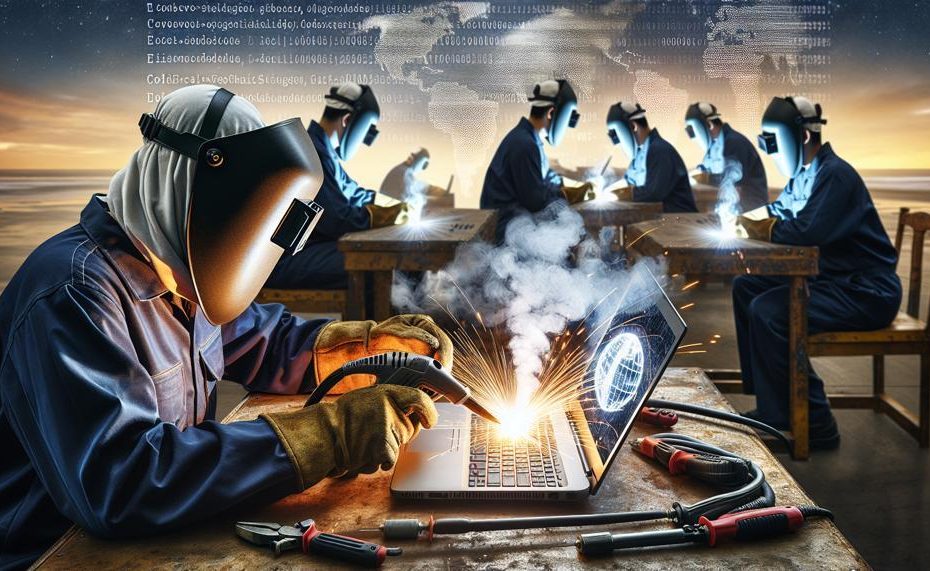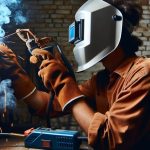Are you ready to spark your career as a coded welder? You are embarking on a dynamic and sought-after profession that offers endless opportunities for growth and advancement. But before you dive into the welding world, it’s crucial to understand the timeline and steps involved in becoming a coded welder.
In this blog post, we will delve into the key points of the process, from training to certification, so you can have a crystal-clear understanding of what it takes to become a skilled and successful coded welder.
So, how long does it take to be a coded welder?
Becoming a coded welder can take several months to a few years. The length of time depends on several factors, including:
- Starting skill level
- Code or standard to meet
- Training path
Formal programs typically last a few months, but self-study may take longer.
A basic certification, like the 3G welding test, can take six weeks to three months for a beginner. A more difficult certification, like the 6G welding test, can take 12 to 18 months for a beginner. Welder coding certificates must be signed every 6 months by a qualified person to confirm the welder is still producing welds of the required standard. They must also be formally re-tested at least every two years.
So, let’s dive into each step together with passion and precision.
Contents
What Is A Coded Welder?
To achieve the prestigious title of a coded welder, certain prerequisites must be met, including specialized training and qualifications. These requirements include being a minimum of 18 years old and possessing a high school diploma or GED. Once these criteria are fulfilled, the following steps must be taken to become a certified or coded welder:
- Enroll in an accredited training program: The first crucial step towards becoming a coded welder is enrolling in an American Welding Society (AWS) accredited training program. These programs provide comprehensive training in various welding processes, safety protocols, and welding codes.
- Obtain specialized certification: Upon completion of the training program, obtaining specialized certification in a specific welding process is necessary, such as MIG, TIG, or stick welding. This entails passing a certification exam that includes both written and hands-on components.
- Familiarize yourself with welding codes: Welding codes are set standards by organizations such as AWS and ASME to ensure quality and safety in welding practices. Becoming familiar with these codes is vital for success on the certification exam.
- Gain practical experience: While training and certification are essential, gaining practical experience through apprenticeships or field work is crucial for developing skills as a coded welder.
By fulfilling these qualifications and successfully completing specialized training and certification, one can attain the esteemed title of a certified or coded welder. With the increasing demand for skilled tradespeople in industries like construction and manufacturing, becoming a coded welder can lead to a lucrative and fulfilling career path.
Welder Coding
Becoming a coded welder requires a specific process that involves training, certification, and practical experience.
It’s a challenging yet rewarding journey that showcases expertise and opens up job opportunities in various industries.
If you’re looking to become a coded welder, here’s what you need to know.
Enroll in an accredited training program:
The first step is to enroll in an accredited training program from reputable organizations such as TWI, Approved TWI Training Centres, AIS Survivex, or The Welding Academy.
These institutions offer comprehensive courses covering various welding techniques and codes.
It’s essential to choose a reputable program to ensure quality training and increase your chances of success.
Obtain specialized certification:
Once you’ve completed your training, you must pass a certification exam to demonstrate proficiency in a specific welding technique.
The welding industry has various codes that govern specific techniques and materials, and being certified in multiple codes can increase your earning potential and job opportunities.
Familiarize yourself with welding codes:
Welding codes are crucial for coded welders as they provide guidelines for specific techniques and materials. The Welding Procedure Specification (WPS) is a vital document for coded welders as it outlines the requirements for welding in a particular code.
It’s important to familiarize yourself with these codes thoroughly to ensure you follow them accurately.
Gain practical experience:
Practical experience is essential for becoming a successful coded welder. This can be gained through apprenticeships or working in the field under the supervision of experienced welders. Practical experience also helps showcase your expertise during the certification process.
Keep up with industry trends:
To stay relevant and competitive as a coded welder, it’s crucial to keep up with industry trends and advancements in welding technology. This can be achieved by attending workshops, seminars, and staying updated with industry news.
Keeping up with industry trends will not only help you stay current but also improve your skills and knowledge as a coded welder.
Welding Qualification Forms
When it comes to welding qualification forms, there are several key pieces of information that are typically included. This includes the welder’s personal details, the specific welding process that was used, the type of material and thickness being welded, as well as the type of joint and position in which the weld was performed.
These details are crucial for ensuring the welder is properly qualified and capable of performing the job at hand.
In addition to these essential details, the form may also include information about the specific code or standard that was followed for the qualification test. This ensures that the welder is meeting industry standards and regulations. Furthermore, acceptance criteria for the test may also be included, which typically involves visual examination (VT) and destructive testing. These tests help determine if the welder is proficient and meets the necessary requirements for qualification.
The results of these tests are then recorded on the form, allowing for a thorough evaluation of the welder’s performance. In some cases, a signature from a supervisor or qualified inspector who oversaw the test may also be required. This adds an extra layer of accountability and ensures that all qualifications are properly verified.
Once a welder has successfully completed their qualification test, their information and results will be recorded on a welder performance qualification record (WPQR). This crucial document must be kept on file for future reference and serves as proof of the welder’s capabilities.
It should be noted that qualifications may expire according to the code or standard being followed, so it is essential to keep track of expiration dates and requalify as needed.
How To Become A Coded Welder
Becoming a coded welder requires dedication and a strong drive to create precise and durable structures. To embark on this journey, follow these steps:
- Cultivate a passion for welding and constructing structures with accuracy and strength.
- Explore reputable institutions, such as TWI, Approved TWI Training Centres, AIS Survivex, and The Welding Academy, for their training programs.
- Enroll in a training program that offers a balance of classroom instruction and hands-on experience.
- Gain practical experience through apprenticeships or by working in the field to refine your skills.
- Familiarize yourself with welding codes from organizations like AWS and ASME, which govern specific techniques and materials used in the industry.
- Take specialized exams for different welding codes to demonstrate your proficiency and boost your career prospects.
- Consider obtaining certification in multiple welding codes to expand your skill set and job opportunities.
- Stay updated on industry developments and advancements in welding techniques by attending workshops and seminars.
- Network with fellow welders and potential employers to find job opportunities and gain valuable insights.
- As the demand for skilled trades continues to increase, continue developing your skills and knowledge to remain competitive in the job market.
The Difference Between Coded Welders And Certified Welders?
The distinction between a coded welder and a certified welder lies in the way they obtain their certification. While a coded welder must pass practical tests to demonstrate their skills, a certified welder is evaluated based on their ability to produce welds that meet specific quality and appearance standards.
This difference is also reflected in the qualifications and skills needed for each certification.
| Coded Welder | Certified Welder | Interchangeable Terms? |
| Must successfully complete practical tests showcasing their proficiency | Must be able to produce welds that meet defined quality and appearance standards | Yes, in certain cases |
| Requires extensive knowledge of welding codes and standards | Not necessarily required to have a deep understanding of welding codes | No |
| May hold multiple certifications for varying codes and standards | Tend to possess only one certification for overall welding capabilities | No |
| Highly skilled in specific welding techniques and materials | Adept in various welding techniques and materials, with an emphasis on quality and appearance | No |
| May need to renew certification periodically by passing updated assessments | May need to renew certification periodically, depending on industry requirements | No |
| Thorough understanding of code requirements for particular projects or industries | Comprehensive comprehension of welding techniques and quality standards for different projects or industries | No |
What Is 6g Coded Welding?
6G coded welding, also known as fixed position welding, is a specialized technique used to join two metal pieces at a 45-degree angle. This type of welding is considered one of the most challenging positions and requires extensive training and certification for welders to perform. It is a highly sought-after skill in the welding industry due to its complexity and difficulty.
For welders, being certified in 6G coded welding is crucial as it guarantees the quality and safety of welded structures. This certification not only opens up more job opportunities but also brings a sense of accomplishment and pride in one’s skillset. It is a mark of expertise and proficiency that sets welders apart from their peers.
To become a certified 6G welder, one must undergo rigorous training and pass a challenging certification test. This process ensures that only the most skilled and knowledgeable welders are certified to perform 6G coded welding. As such, it is a highly respected certification in the welding industry, with many professionals striving to achieve it.
Moreover, 6G coded welding is a versatile technique that can be used in various industries, such as construction, manufacturing, and oil and gas. With the increasing demand for skilled welders in these industries, being certified in 6G coded welding can lead to lucrative job opportunities and career advancement.
What are the different types of welding?
There are a myriad of welding techniques employed in the welding industry, each with its own unique characteristics and applications. These include Gas Metal Arc Welding (GMAW), Gas Tungsten Arc Welding (GTAW), Flux-Cored Arc Welding (FCAW), Shielded Metal Arc Welding (SMAW), and Plasma Arc Welding (PAW). These techniques are utilized in a variety of industries such as automotive, construction, fabrication, shipbuilding, and aerospace.
| Welding Technique | Description | Applications |
|---|---|---|
| Gas Metal Arc Welding (GMAW) | Employs a continuous solid wire electrode and shielding gas to protect the weld from contamination. | Automotive, construction, and fabrication industries. |
| Gas Tungsten Arc Welding (GTAW) | Utilizes a non-consumable tungsten electrode and separate filler material to create high-quality welds. | Aerospace, medical equipment manufacturing, and precision welding applications. |
| Flux-Cored Arc Welding (FCAW) | Makes use of a continuously fed tubular electrode containing flux to create the weld. | Shipbuilding, structural steel fabrication, and heavy equipment manufacturing. |
| Shielded Metal Arc Welding (SMAW) | Uses an electric current to form an arc between a coated metal electrode and the base metal. | Construction, pipelines, and repair work. |
| Plasma Arc Welding (PAW) | Utilizes a constricted arc surrounded by a gas shield to safeguard the weld from contamination. | Aerospace, automotive, and electronics industries. |
In addition to these commonly used techniques, there are also specialized welding techniques such as friction welding, laser welding, and electron beam welding that are employed in specific industries. These methods require specialized training and equipment and are highly sought after skills in the welding industry.
Coded Welders at Varlowe Industrial Services

Becoming a coded welder at Varlowe Industrial Services requires meeting specific requirements for the desired welding code certification. These requirements usually include being at least 18 years old and having a high school diploma or equivalent.
Some codes may also mandate prior welding experience or completion of a training program.
To prepare for the certification process, aspiring coded welders at Varlowe must immerse themselves in the specific welding code they wish to be certified in. This involves obtaining the Welding Procedure Specification (WPS) for that code and studying it thoroughly.
Once the necessary training is complete, the next step is to take and pass a coding test under the supervision of an approved CSWIP examiner. This test evaluates both written knowledge and practical skills to ensure the welder meets industry standards.
Passing the coding test results in certification for the specific welding code, allowing one to work as a coded welder at Varlowe Industrial Services. However, maintaining this certification requires retesting every three years and having certificates signed every six months by either an employer or an examiner.
Varlowe Industrial Services boasts a team of multi-coded welders with expertise in various specifications, materials, diameters, and thicknesses. They also offer nationwide mobile welding services with fully equipped vehicles. The main welding types used at Varlowe include TIG (Gas Tungsten Arc Welding), MIG (Gas Metal Arc Welding), MMA (Shielded Metal Arc Welding), and FCAW (Flux-Cored Arc Welding).
In addition to these services, Varlowe also offers specialized training programs to help aspiring coded welders meet the rigorous requirements for certification. These programs are tailored to each individual’s needs, ensuring they have the necessary skills and knowledge to excel as a coded welder at Varlowe Industrial Services.
Also Read: What Is A Pinch Weld?
Conclusion
In the end, becoming a coded welder is not a simple task, but it is a fulfilling journey that demands perseverance, diligence, and continuous growth.
It requires enrolling in an accredited training program, obtaining specialized certification, gaining hands-on experience, and staying updated on industry advancements. The distinction between a coded welder and a certified welder lies in the method of obtaining their certification.
For those seeking to elevate their welding abilities, 6G coded welding presents the chance to demonstrate proficiency in various positions and angles, making it a highly coveted skill in the welding field.





